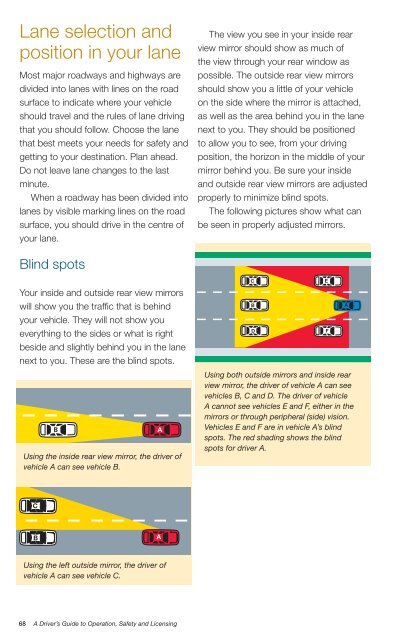DRIVER’S GUIDE
1POl7Ob
1POl7Ob
You also want an ePaper? Increase the reach of your titles
YUMPU automatically turns print PDFs into web optimized ePapers that Google loves.
Lane selection and<br />
position in your lane<br />
Most major roadways and highways are<br />
divided into lanes with lines on the road<br />
surface to indicate where your vehicle<br />
should travel and the rules of lane driving<br />
that you should follow. Choose the lane<br />
that best meets your needs for safety and<br />
getting to your destination. Plan ahead.<br />
Do not leave lane changes to the last<br />
minute.<br />
When a roadway has been divided into<br />
lanes by visible marking lines on the road<br />
surface, you should drive in the centre of<br />
your lane.<br />
The view you see in your inside rear<br />
view mirror should show as much of<br />
the view through your rear window as<br />
possible. The outside rear view mirrors<br />
should show you a little of your vehicle<br />
on the side where the mirror is attached,<br />
as well as the area behind you in the lane<br />
next to you. They should be positioned<br />
to allow you to see, from your driving<br />
position, the horizon in the middle of your<br />
mirror behind you. Be sure your inside<br />
and outside rear view mirrors are adjusted<br />
properly to minimize blind spots.<br />
The following pictures show what can<br />
be seen in properly adjusted mirrors.<br />
Blind spots<br />
Your inside and outside rear view mirrors<br />
will show you the traffic that is behind<br />
your vehicle. They will not show you<br />
everything to the sides or what is right<br />
beside and slightly behind you in the lane<br />
next to you. These are the blind spots.<br />
B<br />
Using the inside rear view mirror, the driver of<br />
vehicle A can see vehicle B.<br />
A<br />
Using both outside mirrors and inside rear<br />
view mirror, the driver of vehicle A can see<br />
vehicles B, C and D. The driver of vehicle<br />
A cannot see vehicles E and F, either in the<br />
mirrors or through peripheral (side) vision.<br />
Vehicles E and F are in vehicle A’s blind<br />
spots. The red shading shows the blind<br />
spots for driver A.<br />
Using the left outside mirror, the driver of<br />
vehicle A can see vehicle C.<br />
68 A Driver’s Guide to Operation, Safety and Licensing


